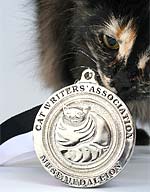 |
|||||||||||||||||||
|
|

We are the proud winners of the 2006 - 2009 winner of the Muse Medallion for Online Magazine by The Cat Writers? Association in their annual Communications Contest! (Photo courtesy of Weems Hutto).
On November 17, 2007 Felinexpress.com was honored to receive The President's Award by the Cat Writers' Association. We are very proud to have earned this distinction and will continue to provide quality information for all cat lovers.
Felinexpress.com Home > Cat Health > Natural Flea Control for Cats |
Natural Flea Control for Cats
Just because a flea control product says “Natural” on the label, doesn’t mean that the product is safe to use for flea control. In a Google Search for natural flea control for cats- the first thing to pop up is an ad for chemically treating your cat for fleas. Scrolling down further, you will find various websites proclaiming to have the answer in ultimate, natural flea control. Let’s just list some of these choices and then let’s tak a reality check.
- Pennyroyal
Reality Check- If used full strength it turns toxic to your cat - Garlic-
Reality Check-Can cause Heinz Body Anemia. - Eucalyptus oil-
Reality Check-Toxic to cats - Tea Tree Oil-
Reality Check-Deadly to your cat - Sulfur-
Reality Check- Some sulfur compounds can cause digestive issues. - Black Walnut Hulls-
Reality Check-Toxic to dogs do you want to take a chance with your cat?
These choices shown above are NOT safe for cats. Each one carries its own risk to the health of your cat, and if accidentally ingested- several of them will cause death. So what natural flea products are safe for your cat?
Safe Natural Flea Remedies
Before you launch a campaign against fleas, be sure your cat has fleas. Using a flea comb and a piece of white paper, comb your kitty’s fur thoroughly- be sure to comb the tummy, the head and the base of the tail.
Hold the comb over the white sheet of paper. Use your fingers to rake out the hairs caught in the comb. If you see little black specks falling- that is flea dirt so your cat has fleas. If the infestation is advanced you will also see mature and immature fleas on the paper.
Launch a yard attack.
If your cat has fleas and is an indoor-only cat, then the fleas are possibly in your yard.
Yard Flea Spray:
- 1 tablespoon DAWN liquid soap
- 1 gallon rainwater or soft water (do not use hard water)
- 2 cups rubbing alcohol
Mix the DAWN liquid with the water in a large hose sprayer. Add the alcohol and just before dusk, soak your yard. The rubbing alcohol weakens the fleas’ protective covers and then the DAWN will kill them. This spray is safe to use in the yard even if you have outside pets. It is not safe to use as flea soap on your cat or your dog. The plus of this solution is it kills ticks too!
Diatomaceous earth crystals- Use caution as you need to find food-grade diatomaceous earth crystals. You can find these at a high-grade nursery or garden store. These critters lived in the sea over 30 million years ago. Their fossilized remains are turned into fine powder or dust. You can use a large empty baby powder container and fill it up and start sprinkling the substance all around your yard. The beauty of this natural flea control is you can bring this inside and sprinkle it on your carpets and bedding. Wait a few days later to vacuum though, so it can successfully kill off any fleas in your home. The fleas die from dehydration. The sharp edges of these sea creatures puncture their outside protection leaving them vulnerable. Diatomaceous earth is also known as Chinchilla Dust. You can find this at a pet store.
This will also kill ticks.
Make Worms Your Warriors:
Nematodes or microscopic worms love to eat fleas for breakfast, lunch and dinner. Buy these at garden centers or nurseries. Load up your sprayer, following the directions on the package and blast those bloodsuckers. When the fleas are gone the nematodes vanish as well.
Pick up clutter-
Fleas love damp, moist areas. Pick up the clutter around the yard and take away any welcome mats for the fleas.
Preventing Fleas Indoors:
Buy a flea collar. No, don’t put the flea collar on your cat, cut the collar up in small pieces and put it into a sealed plastic bag. Before vacuuming, take a few pieces and put into the vacuum bag where it will kill fleas.
Or if no flea collar is available after vacuuming or if your bag isn’t full, put the bag into your freezer overnight. Empty the bag after 24 hours in the deep freeze.
Wash all the pet bedding in your washing machine at least once a week. Add just a small amount of flea shampoo for cats only into the cycle. Run the hottest water cycle you can.
Buy several night lights and set them up. Underneath each light, place a pie pan of water. At night, the fleas will be attracted to the light and jump into the water and eventually drown.
Brewer’s Yeast- the object behind using Brewer’s Yeast is to leave a bad taste in the flea’s mouth when she takes a healthy bite of your cat. You would mix this into the food. But some cats are allergic to Brewer’s Yeast and will develop skin issues that have nothing to do with a flea problem so use care when using this product.
Fleas: The opportunistic bloodsuckers
Keeping your cat healthy will cut down on flea invasions. Fleas often take advantage of weak and sick.
Be a Clean Freak:
Wash your cat’s bedding and yours as well at least once a week, Vacuum daily and pick up any clutter in the house. A flea’s life cycle can become disrupted if their real estate keeps changing on a regular basis. Change throw rugs often during the summer months. Steam clean your carpets at the beginning of flea season. If you have an ant invasion, don’t be so quick to discourage them. Ants love to put fleas on their menu.
Sprinkle food-grade Diatomaceous earth along your baseboards and in cracks and crevices where fleas live. It is also safe to sprinkle on your carpet.
We live in a toxic world. The household cleaners, soaps, shampoos we all enjoy contain chemicals that are toxic to our cat. Even the chocolate we indulge in or the potted plant on the table could be the demise of our cat. Adding to that toxicity and using chemicals (pesticides) to control fleas makes the cat’s world even more dangerous. One afternoon while using a popular brand of flea control (a topical treatment) I accidentally spilled a drop on my counter. The chemical landed on a plastic cover for a container. To my horror, I watched the plastic slowly melt away where the chemical had landed. Now, I only use the topical spot-on treatments in dire circumstances (where the fleas are killing the cat or kitten) otherwise, I go the natural route. Not only have I found it better for my cats and the environment but it is also easier on the wallet.
More cat breeds |
|
? Copyright 2006-2010 Felinexpress.com, All Rights Reserved
Privacy Statement - Disclaimer - About Me


